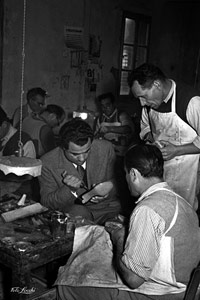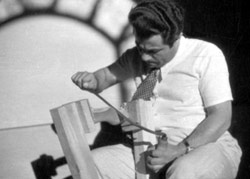Salvatore Ferragamo
Salvatore Ferragamo was born, the eleventh of fourteen children, in 1898 in Bonito, Naples. Even before he reached adolescence, he revealed a great passion for  shoes; at the age of 11 he was apprenticed to a shoemaker in Naples and at 13 he opened his own shop in Bonito. Salvatore certainly knew what he wanted, to ennoble a trade considered humble and create a form of high craftsmanship aiming at no less than functional and aesthetic perfection. shoes; at the age of 11 he was apprenticed to a shoemaker in Naples and at 13 he opened his own shop in Bonito. Salvatore certainly knew what he wanted, to ennoble a trade considered humble and create a form of high craftsmanship aiming at no less than functional and aesthetic perfection.
The Great American Adventure: At the age of 14 he went to America to join one of his brothers who was working in a large footwear company in Boston. Salvatore was fascinated by the modern machinery and working procedures but at the same time saw its quality limitations.
In the early Twenties he moved to Santa Barbara, California, to join another brother and there he opened a shoe-repair shop.
Meeting the Movies: California was a dreamland in those years and so was its film industry. Salvatore began to design and make cowboy boots for Westerns and Roman and Egyptian sandals for epics by major directors and producers. Actors and actresses became aware of the beauty and comfort of Salvatore's shoes and soon began to order footwear for off the set.
Meanwhile Salvatore himself, in his constant search for "shoes which fit perfectly" studied human anatomy, chemical engineering and mathematics at university in Los Angeles.
Success and Fame: When the movie industry moved to Hollywood, Salvatore Ferragamo followed. In 1923 he opened the 'Hollywood Boot Shop', which marked the start of his career as "shoemaker to the stars", as he was defined by the local press. Famous names such as Mary Pickford, Rudolf Valentino, John Barrymore Jr., Douglas Fairbanks, Gloria Swanson and others became his devoted customers and his popularity boomed. Salvatore was ahead of the times and radically changed footwear fashion in that period. He opened up women's shoes, until then straight-laced and closed, making them more elegant and comfortable, and he also created the first sandals.
The Choice of Florence: His success was such that he couldn't keep pace with the orders, but American labour wasn't capable of making the shoes Ferragamo wanted and in 1927 he decided to return to Italy, to Florence, a city traditionally rich in skilled craftsmanship. From his Florentine workshop in which he adapted production line techniques to the specialized and strictly manual operations of his own workers he launched a constant stream of exports to the States.
Italy to the Rescue: Then came the great crisis of 1929, which brusquely interrupted relations with the American market, and the firm had to close. Ferragamo didn't lose heart however, turning his energies instead to the national market. By 1936 business was going so well he rented two workshops and a shop in Palazzo Spini Feroni, in Via Tornabuoni. Those were years of economic sanctions against Mussolini's Italy and it was in that period that Ferragamo turned out some of his most popular and widely imitated creations, such as the strong but light cork 'wedges'. Cork, wood, metal wire, raffia, felt, and glass like synthetic resins were among the innovative materials that Ferragamo used to creatively replace the leather and steel which trade restrictions prevented him from using.
 On the strength of his success, in 1938 Ferragamo was in a position to pay the first installment for the purchase of the entire Palazzo Spini Feroni, which had been Company headquarters ever since. It was followed shortly afterwards by the purchase of a villa, 'Il Palagio', in the hills of Fiesole, as a private residence. In 1940 he married Wanda Miletti, the young daughter of the local doctor in Bonito, who followed him to Florence and who was to bear him six children, three sons (Ferruccio, Leonardo and Massimo) and three daughters (Fiamma, Giovanna and Fulvia). On the strength of his success, in 1938 Ferragamo was in a position to pay the first installment for the purchase of the entire Palazzo Spini Feroni, which had been Company headquarters ever since. It was followed shortly afterwards by the purchase of a villa, 'Il Palagio', in the hills of Fiesole, as a private residence. In 1940 he married Wanda Miletti, the young daughter of the local doctor in Bonito, who followed him to Florence and who was to bear him six children, three sons (Ferruccio, Leonardo and Massimo) and three daughters (Fiamma, Giovanna and Fulvia).
International Success Again: In the post war period, all over the world the shoes of Salvatore Ferragamo became a symbol of Italy's reconstruction, through design and production. Those were years of memorable inventions: the metal reinforced stiletto heels made famous by Marilyn Monroe, gold sandals, and the 'invisible' sandals with uppers made from nylon thread (which in 1947 were to win Ferragamo the prestigious 'Neiman Marcus Award', the Oscar of the fashion world, awarded for the first time to a footwear designer). In 1950 the Company numbered 700 employees and was producing 350 shoes a day by hand. Success was once again international: the Via Tornabuoni shop became an essential stop off for personalities such as Greta Garbo, Sofia Loren, Anna Magnani, the Duke and Duchess of Windsor and Audrey Hepburn, who all had their shoes made to measure there.
Those years saw the first and relative mechanization of production; relative because Ferragamo saw machinery as indispensable for the less elaborate work but believed all the rest should be done by hand and under strict human supervision. |






